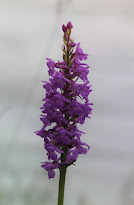Prehistoric Perambulation
It was a new destination for me today as I decided to combine human and natural history at the Bickerton Hill site on the south-west border of Cheshire. On a day which started gloomy but which warmed up considerably once the sun breached the clouds, I tentatively progressed up a very unpromising track to the car park at the foot of a glorious stretch of lowland heath. Spikes of foxglove, purple, white and all shades in between, protruded from the bracken as I ventured up the right hand footpath towards Kitty's Stone. On this stretch bracken and closely-cropped turf covered the sandstone, with fewer of the bare patches of earth and sand than on the main heath. I had hoped to spot some of the reptile species which make this site their home but even as the weather turned hotter it was a forlorn quest despite my careful checking of every tree stump, patch of earth or sheltered hollow in the bracken. Instead there was an abundance of grasshoppers and 7-spot ladybirds with butterflies including red admiral and large white.
Foxgloves Different faces of Bickerton Hill
At the top of the climb approaching Kitty's Stone a path ran left towards the open heath. Here the vegetation changed to heather and cross-leaved heath, the two plants forming thick carpets alongside bilberry. Bumblebees were enjoying the sunshine and I disturbed a few flighty silver Y moths as I passed by. The occasional tree breached the heath and in one pine a great spotted woodpecker was perched and wren, willow warbler and chiffchaff were in good voice.
I began the climb up towards Maiden Castle, the initial slope thickly covered in silver birch with two speckled wood butterflies resting in spots of sunlight, before emerging on the open crown of the hill fort. Maiden Castle is Iron Age, one of only a handful of hill forts along the Cheshire Sandstone Trail, and whilst it probably requires an antiquarian's eye to pick out the prehistoric features even I could enjoy the view our ancient ancestors must likewise have gazed out upon.
The Cheshire Plain from Maiden Castle
Today the Cheshire Plain reflects the fertile soil with rich, lush pastures and the occasional yellow patch of rape crop. I suspect it was much more forested in those times and perhaps the tower block buildings towards Chester and the Wirral weren't quite as prominent then as now. However I'm sure that the croak of the raven and the mew of a circling buzzard - if ever a sound epitomised this landscape then it is that one - would have been heard then as I heard it now, and perhaps the ancestor of the small rodent which scurried across the path - presumed field vole - was also around back then.
On my journey back to base I stopped off at the Witton Lime Beds to have another search for the fragrant orchids which grow in profusion here. Once again my ability to follow straightforward directions proved in question and I had almost given up when I spotted a handful of plants growing beside the path leading through the Neumann's Flash reedbeds to the viewing screen. Some of these grew several feet tall whilst the curious mallards and mute swan were an unusual backdrop. Back at base and a check on the trail camera showed more hedgehog activity overnight - the local cats are cottoning on to the food source so it is going to need a bit quicker to the punch at this rate.











Comments
Post a Comment